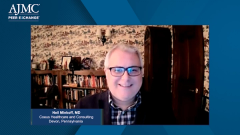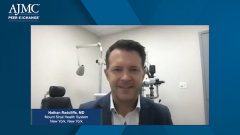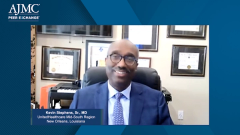
Glaucoma: Utilization Management and Patient Access to Therapy
Following a brief discussion on utilization management, experts discuss the current paradigm of patient access to therapy.
Episodes in this series

Transcript:
Neil Minkoff, MD: Dr Stephens, could you also weigh in on how utilization management is looked at for glaucoma therapies or agents?
Kevin Stephens, Sr., MD: The big thing here is that with this disease process you have irreversible vision loss. And once you have nerve damage, it is not restored generally as a rule of thumb. That’s still important. Our goal is to make sure that we get everybody engaged and started in the process and we have a good utilization management process.
Neil Minkoff, MD: If we were to compare, and I’ll ask you an out-of-the-box question, if we were to compare it to let’s say utilization management in diabetes or in MS [multiple sclerosis] or a disease like that, would you say that this is similar or less managed?
Kevin Stephens, Sr., MD: It’s much less managed. We have very few prior authorizations because vision is critical. It’s the eye to the soul, so to speak, and it’s very important. We try to get it out of the way because, as it is, many times the diagnosis is made late, many times the disease has already progressed. And you don’t want to be an impediment to this process because of the burden that it can bring on if not treated properly and adequately. We try our best to make sure we follow, and they have national guidelines, and we have a peer to peer process. We try to make it easy for the providers to get in and to get what’s needed for that person because, as we know, no two people are alike. And we try to have the flexibility in the management of this disease process.
Neil Minkoff, MD: Now I’m going to be controversial. We’ve got 2 very established payors, people with a lot of experience say there is a low UM [utilization management] class of therapy. I would be very curious to hear from our glaucoma specialists if that has been consistent with their experience or if they feel that the payors are putting barriers in their way to get what they want for their patients.
Terri-Diann Pickering, MD: I would say that over the decades of my practice, when I first started practice, I would just write a drop on a prescription pad, the patient would take it to the pharmacy, and it would get filled. Now, we have increased staff because we have to process multiple prior authorizations and appeals, and even forms for patients who need to go through the patient assistance programs from the pharmaceutical companies themselves. What you’ll find is that the generics are at a very low-cost tier but anything else is at a higher tier. In theory, the drop is covered but it’s covered at such a high cost that the patient still can’t afford it. And there’s really no appeal because in theory the drop is covered.
It’s frustrating to give them a branded sample that works, but they still can’t afford it. Some patients fail generics and that’s important to understand, especially in the prostaglandin analogues. The generics and the branded names, they can be quite different. Sometimes people must switch back and forth between the 2. When it happens, we simply can’t revert to a generic. The other problem with generics is that not all of the combination drops are generic. Combination drops are extremely important because they help with adherence and help to control intraocular pressure, but they frequently are not covered because they’re branded. That can be frustrating.
Neil Minkoff, MD: Dr Radcliffe, how does that fit with your experience?
Nathan Radcliffe, MD: Yes, I was thinking the first 5 years of my career I didn’t know what insurance anyone had. The second 5 years I felt guilty when I had to ask, and I know the insurance companies and I’m playing some sort of incredible complex game in my head where I’m matching therapies to insurance plans which was not information I was looking forward to acquiring but it is necessary. It’s true that, in many ways, the insurance companies stay out of the way and it’s branded pharmacotherapy.
The glaucoma pharmaceutical landscape is mostly generalized but remember that the eye is not the stomach. The stomach, as far as I can tell, was put on the planet to absorb things and the eye was put on the planet to keep things out of it. And our patients can be very sensitive to the pH, the preservative, the excipients in the drop as well as the molecules, and we do need these alternative formulations. I have patients where there’s just 1 drop on this planet that works for them, and they have to have it. Not everyone, but a proportion of patients can be sensitive like that, and we will often struggle to get those patients balanced. And, of course, brand name therapies are often part of the solution. Preservative-free is a great example of expensive therapies, often not with great coverage that some patients just need. And, often, those patients will have a little bit of trouble getting them. I understand why it’s the situation, but it does take some maneuvering for the doctor to manage the insurance plans.
Transcript edited for clarity.
Newsletter
Stay ahead of policy, cost, and value—subscribe to AJMC for expert insights at the intersection of clinical care and health economics.



































































